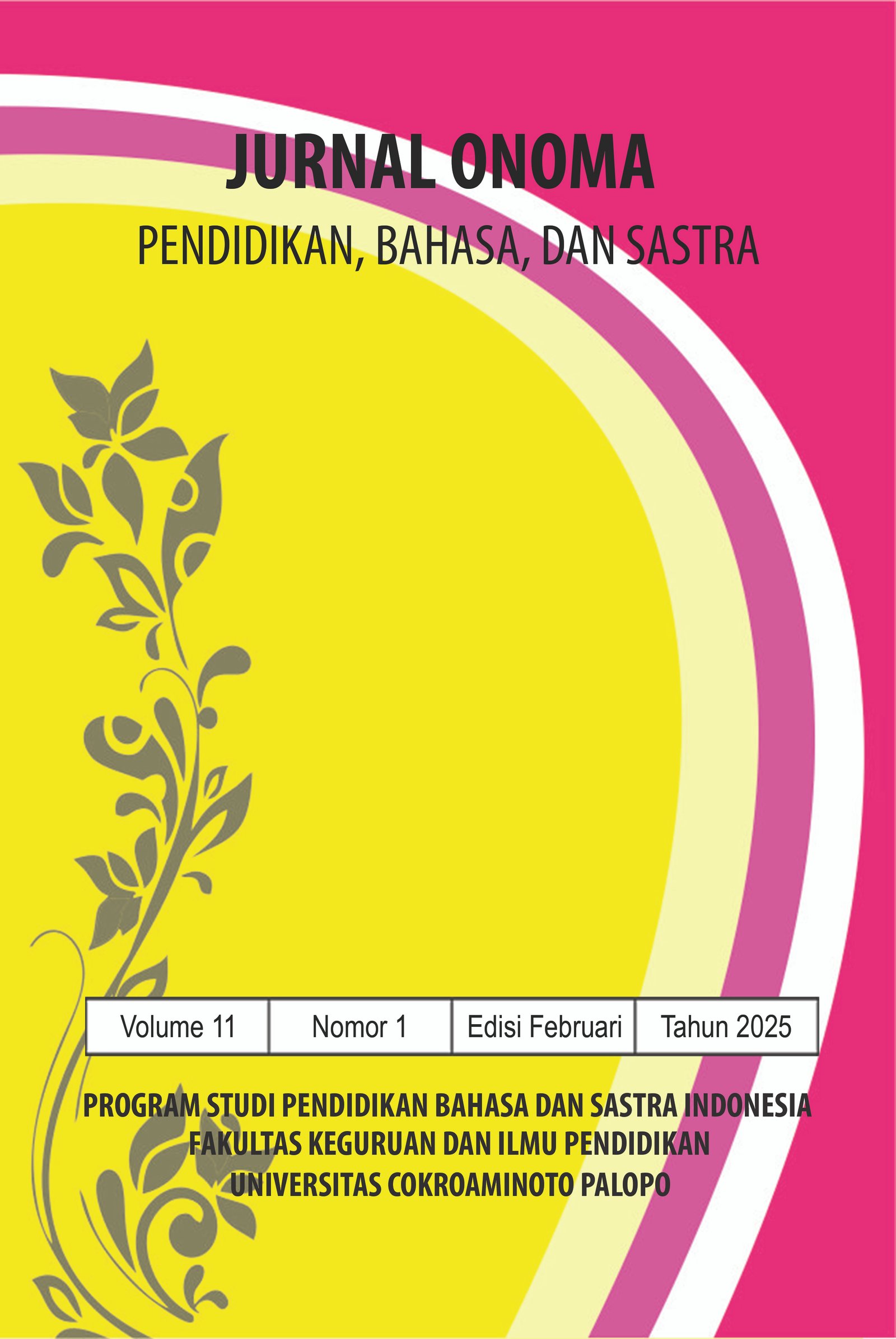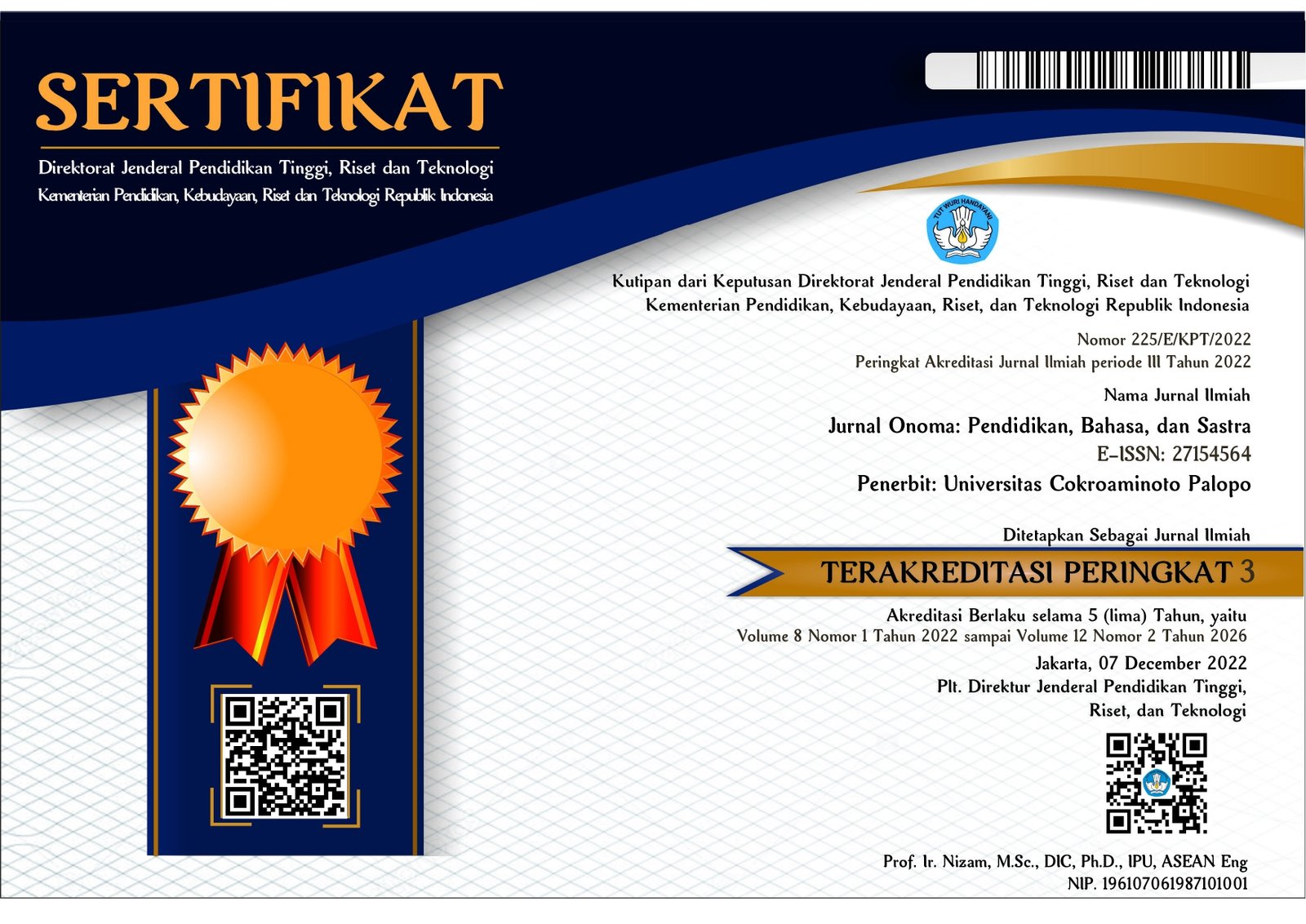Ma’nene’ Sebagai Ekspresi Liturgis: Memahami Ma’nene’ sebagai Perayaan Liturgis dengan Pendekatan Anamnesis
https://doi.org/10.30605/onoma.v11i1.5413
Keywords:
Anamnesis, Ma’nene’, liturgi, perayaan.Abstract
Tulisan ini mengeksplorasi praktik Ma’nene’ yang dilakukan oleh orang Toraja-Kristen. Penelitian ini menempatkan Ma’nene’ sebagai perayaan liturgis melalui pendekatan anamnesis, yaitu pengingatan dan perayaan atas kehadiran Tuhan dalam kehidupan sehari-hari. Meskipun Ma’nene’ sering dianggap problematis dalam konteks kekristenan, pendekatan ini menawarkan integrasi ritus dan etos sebagai ekspresi iman. Dengan metode kualitatif berbasis observasi, wawancara, dan studi pustaka, penelitian menunjukkan bahwa Ma’nene’ menghubungkan dimensi kultural, historis, dan teologis. Dalam perspektif anamnesis, seluruh tahapan ritual Ma’nene’, termasuk pemberian persembahan dan jamuan, adalah perayaan liturgis. Ma’nene’ merefleksikan penghayatan akan kasih Allah dan pemeliharaan-Nya yang tak berkesudahan. Penelitian ini menyimpulkan bahwa Ma’nene’ dapat menjadi sarana dialog antara iman Kristen dan tradisi ketorajaan, sekaligus menjadi pengingat akan kehadiran Kristus dalam kehidupan komunitas Toraja.
Downloads
References
Andreopoulos, A., & Harper, D. (Eds.). (2018). Christos Yannaras: Philosophy, theology, culture. Routledge. DOI: https://doi.org/10.4324/9780429442735
Brown, C. (Ed.). (1971). The New International Dictionary of New Testament Theology (Vol. 3). Zondervan.
Gereja Toraja. (2018). Buku Liturgi Gereja Toraja.
Harris, R. L., Archer, G. L., & Waltke, B. K. (Eds.). (1980). Theological wordbook of the Old Testament. Moody Press.
Haryeni Tamin, Hasan, H., Kasmawati, K., & Indarwati, I. (2021). Bentuk dan Makna Ritual Ma’nene’ To Sarani di Toraja Utara. Jurnal Onoma: Pendidikan, Bahasa, Dan Sastra, 7(2), 462–469. https://doi.org/10.30605/onoma.v7i2.1300 DOI: https://doi.org/10.30605/onoma.v7i2.1300
Jamahh, V. U. (2015). The Role of the Liturgy in the Formation and Sustenance of Christian Cultural Memory in the family: An Impulse from early Christianity for the New Evangelization. Jorah, 5, 33–48.
Kobong, T. (2008). Injil dan Tongkonan: Inkarnasi, kontekstualisasi, transformasi (Cet. 1). BPK Gunung Mulia.
Kristanto, K., Özkizmaz, Y., Allo, M. D. G., & Mangolo, Y. (2024). The Corpse in the Grave: A Theological-Ethical Study of the Ma’nene Tradition in the Torajan Context. Jurnal Jaffray, 22(1), 1. https://doi.org/10.25278/jj.v22i1.889 DOI: https://doi.org/10.25278/jj.v22i1.889
Lacoste, J.-Y. (2004). Experience and the absolute: Disputed questions on the humanity of man (1. ed). Fordham University Press.
Martasudjita, E. (1998). Makna Liturgi bagi Kehidupan Sehari-hari: Memahami Liturgi secara Kontekstual. Kanisius.
Matasak, M. F. (2013). Ritual Ma’nene’: Suatu Tinjauan Sosio-Teologis terhadap Makna Ritual Ma’nene’ di Lembang Lempo Poton Kecamatan Rindingallo. Universitas Kristen Indonesia Toraja.
Morrill, B. T. (2020). Models of Liturgical Memory: Mystical-Political Dimensions, Mythic-Historic Tensions. Studia Liturgica, 50(1), 40–54. DOI: https://doi.org/10.1177/0039320719884125
Pakpahan, B. J. (2012). Allah Mengingat: Teologi Ingatan Sebagai Dasar Rekonsiliasi dalam Konflik Komunal. BPK Gunung Mulia.
Panjaitan, B. J. (2013). Teologi Ingatan Sebagai Dasar Rekonsiliasi Dalam Konflik. Diskursus - Jurnal Filsafat Dan Teologi STF Driyarkara, 12(2), 253–277. DOI: https://doi.org/10.36383/diskursus.v12i2.107
Plaisier, B., Kobong, T., End, T. van den, & Purwanto, W. (2016). Menjembatani jurang, menembus batas: Komunikasi Injil di wilayah Toraja, 1913-1942 (Cetakan ke-1). BPK Gunung Mulia.
Sarira, J. A. (1996). Aluk Rabu Solo’ dan Persepsi Orang Kristen terhadap Rambu Solo’. Pusbang - Badan Pekerja Sinode Gereja Toraja.
Scott, H. (2021). “Lest We Forget”: A Postapartheid Perspective on Remembering in Liturgy for Healing and Justice. Studia Liturgica, 51(1), 60–72. DOI: https://doi.org/10.1177/0039320720978919
Šmeman, A. D. (1973). For the life of the world: Sacraments and Orthodoxy (2nd rev. ed). St. Vladimir’s seminary press.
Smith, J. K. A. (2009). Desiring the kingdom: Worship, worldview, and cultural formation. Baker Academic.
Sutanto, E. A. (2005). Liturgi Meja Tuhan: Dinamika Perayaan-Pelayanan. UPI STT Jakarta.
Toraja, G. (2023). Pengakuan Gereja Toraja. Badan Pekerja Sinode Gereja Toraja.
Volkman, T. A. (1985). Feasts of Honor" Ritual and Change in the Toraja Highlands. University of Illinois Press.
Downloads
Published
How to Cite
Issue
Section
License
In submitting the manuscript to the journal, the authors certify that:
- They are authorized by their co-authors to enter into these arrangements.
- The work described has not been formally published before, except in the form of an abstract or as part of a published lecture, review, thesis, or overlay journal.
- That it is not under consideration for publication elsewhere,
- That its publication has been approved by all the author(s) and by the responsible authorities – tacitly or explicitly – of the institutes where the work has been carried out.
- They secure the right to reproduce any material that has already been published or copyrighted elsewhere.
- They agree to the following license and copyright agreement.
License and Copyright Agreement
Authors who publish with Onoma Journal: Education, Languages??, and Literature agree to the following terms:
- Authors retain copyright and grant the journal right of first publication with the work simultaneously licensed under Creative Commons Attribution License (CC BY 4.0) that allows others to share the work with an acknowledgment of the work's authorship and initial publication in this journal.
- Authors are able to enter into separate, additional contractual arrangements for the non-exclusive distribution of the journal's published version of the work (e.g., post it to an institutional repository or publish it in a book), with an acknowledgment of its initial publication in this journal.
- Authors are permitted and encouraged to post their work online (e.g., in institutional repositories or on their website) prior to and during the submission process, as it can lead to productive exchanges, as well as earlier and greater citation of published work.

















